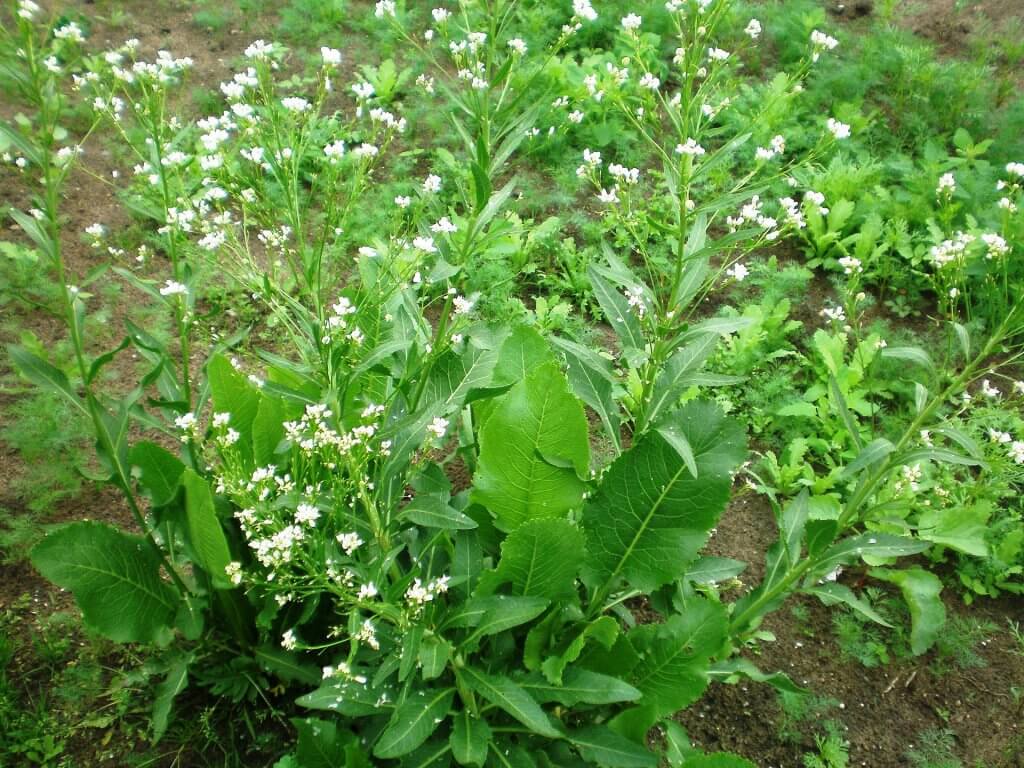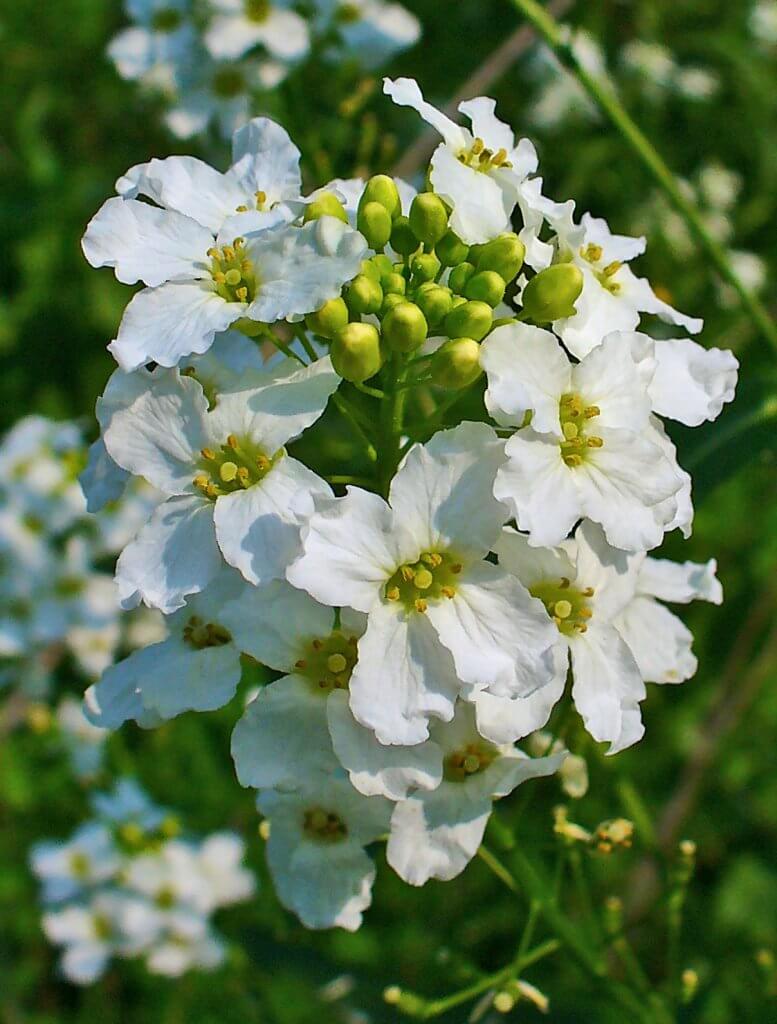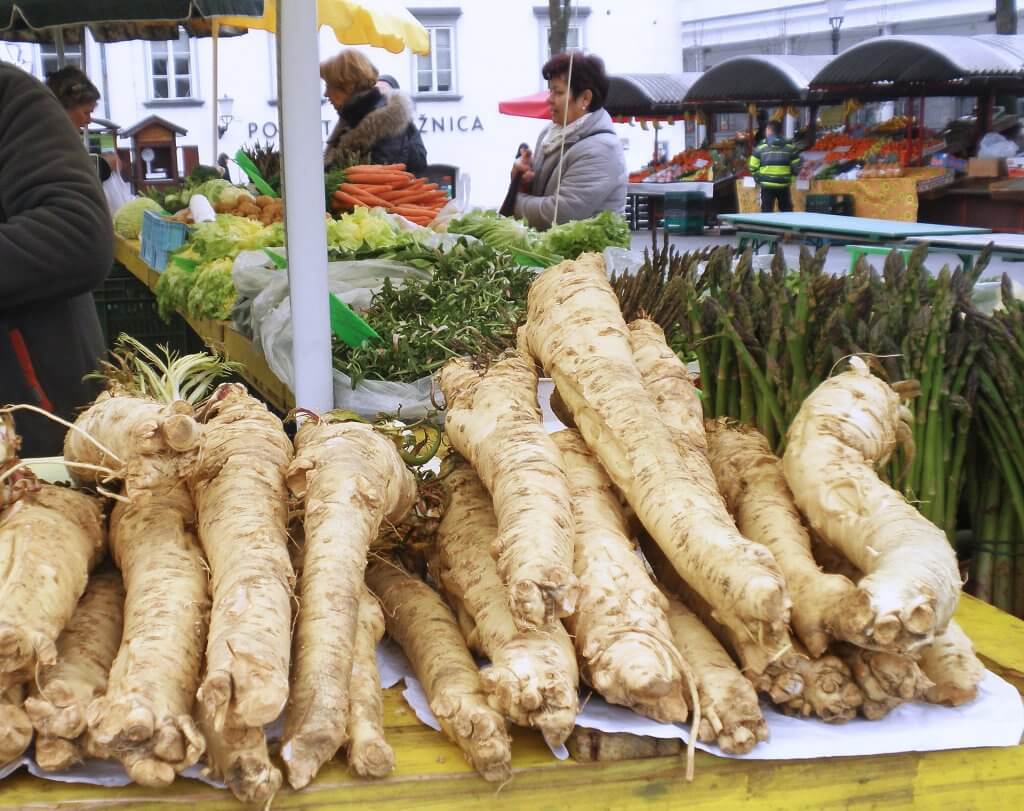Horseradish (Armoracia rusticana) is a perennial plant, related to wasabi, mustard and broccoli. Originally native only to parts of Western Asia and South Eastern Europe. You can now find horseradish grown worldwide for its culinary value. You will see it growing wild alongside hedgerows, embankments and ditch edges. Horseradish is particularly hardy, so where ever a root has managed to take hold in can usually grow.
The root of horseradish is thick and fleshy, and you can often find it growing to 50cm in length. The long crinkled, leaves will generally grow in a distinctive rosette shape from the base of the plant. When flowering in summer you will see small clusters of simple white flowers.
Generally you will only see the roots of horseradish being used as a vegetable or spice, however the leaves are also edible. The root has a pungent and spicy taste, with the leaves having a slightly more mild, bitter and peppery taste.

Cultivation and History of Horseradish
Horseradish is an extremely easy plant to grow and harvest. Due to its hardiness within the wild, you do not need very specific growing conditions to successfully grow horseradish. It has been cultivated for hundreds of years for its culinary and medicinal values.

It tends to prefer a sunny spot with partial shade and well draining soil. You may also choose to plant horseradish within a container as it does have a habitat of spreading quickly. Plant the roots or seeds straight into the ground during fall or winter. Cuttings can be planted just after the last frosts have passed. Leaves will begin to develop and mature through the spring. These can be harvested for use within salads or sauces.
If flower buds develop consider removing them to allow the plant to focus all energy into the leaves and root system. The roots can easily be harvested once the plant has matured during the fall. Due to the long taproot within horseradish, it is likely to return again next year without need for replanting.
Is Horseradish toxic?
You can safely eat horseradish leaves and roots, however eating large amounts is likely to cause stomach upset. The chemicals that give horseradish its flavor are considered volatile. This means in high amounts they can begin to negatively effect your body. Even small amounts of horseradish can irritate the lining of your nose and mouth. If you are pregnant, breast feeding or suffer from stomach ulcers or conditions, horseradish consumption should be greatly limited or avoided.
Uses
Culinary uses of Horseradish
You can use raw horseradish leaves within salads or even pesto. Alternatively you could sauté or add them into soups, casseroles or a stir fry. Today horseradish is commonly used as a sauce throughout Europe, the US and other countries. It is particularly popular in the UK as a condiment used to accompany roast beef, eaten as a traditional Sunday roast.
Horseradish also has a long culinary history. Since the middle ages its spicy and pungent taste has been favored. German people once used crushed horseradish with a little vinegar to create a spiced sauce for flavoring meat and fish.

Medicinal uses of Horseradish
The entire plant was once used as an ingredient in traditional remedies and medicines. Throughout the middle ages, it was used to treat coughs, colds and aid digestion. It was also applied topically to inflamed and arthritic joints to ease pain. Many also believed it could treat kidney and bladder conditions, scurvy and to remove intestinal worms. Today, many herbalists may use it for congestion relief as its powerful flavor can stimulate the lining of the sinus.
Did you know…
Wasabi and horseradish have very similar flavors. Due to the high popularity of wasabi and its limited availability as a plant, many wasabi sauces are now made using horseradish.
Conclusion
You can use horseradish in a variety of ways in the kitchen, from grating it over a dish of mascarpone and baked potatoes or roasting it alongside other vegetables. Horseradish can be much more than just a sauce. Horseradish has a high amount of vitamin C, making it a nutritious and delicious root vegetable to experiment with. Raw horseradish is not always easy to find within supermarkets or farmers markets. So, growing your own is a great way to have the root on hand for a homemade sauce.
—————Written by Hannah Sweet
Hannah is a freelance writer and graphic designer from the UK. With a penchant for travelling, photography and all things botanical, she enjoys writing about a wealth of topics and issues, from conservation and slow living, to design and travel. Learn more about her writing and design services at www.sweetmeanders.co
Many of our readers find that subscribing to Eat The Planet is the best way to make sure they don't miss any of our valuable information about wild edibles.
See our privacy policy for more information about ads on this site






